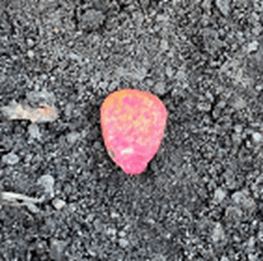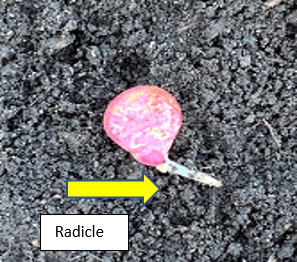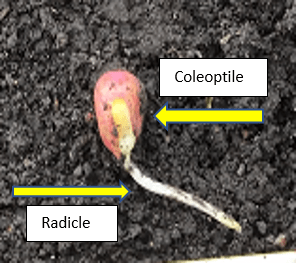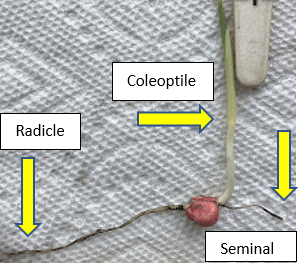Corn Germination and Emergence
BY Dairyland Seed Agronomy Team
In the last week to ten days some areas have had favorable weather that has allowed farmers to plant corn. A corn seed has a few processes that it needs to accomplish prior to soil emergence.
One of the processes is germination, which takes place when a seed takes in or imbibes roughly 30 percent of its weight in water. During this process the seed will swell slightly. In most instances germination or seed swelling takes roughly 10 to 20 Growing Degree Units (GDUs). (This is shown below and on the left.)


Once germination has initiated, the radicle root will start to emerge, it normally takes 30 to 40 GDUs for the radicle root to emerge. (This is shown in the photo above and on the right). The radical always emerges from the tip of the embryo and will orient itself due to gravity so it is growing down, regardless of where the embryo of the seed is pointed. The ability of the plant to sense gravity is called Gravitropism or Geotropism.
The next process is for the coleoptile to emerge from the seed (as shown below and on the left). It normally takes 50 to 60 GDUs for the coleoptile to emerge from the seed. Starting between 60 to 70 GDUs, the seminal root system will start to emerge from the seed and almost immediately start taking in water and nutrients for the plant to continue to grow. The seminal root system and the radicle will anchor the plant and act as the main root system for the plant until VE (shoot/spike coleoptile emergence) and will continue to grow until V3 (three-collared corn).


It normally takes 100 to 150 GDUs for the coleoptile to emerge (VE) from the soil surface (as shown above and on the right) with weather conditions and genetic makeup being factors affecting this process. At VE, the coleoptile will cease to elongate and the foliage that follows will be the embryonic leaves.
|
Plant / Leaf Stage |
Growth Stage |
GDUs |
|
Germination |
10 to 20 |
|
|
Radicle Root Emergence |
30 to 40 |
|
|
Coleoptile Emergence Seed |
50 to 60 |
|
|
Seminal Root Emergence |
60 to 70 |
|
|
Coleoptile Emergence Soil |
VE |
100 to 150 |

Brian Weller
Western Region
507.456.3034

Rod Moran
Western Region
507.456.3034

Dan Ritter
Central Region
219.863.0583

Branden Furseth
Northern Region
608.513.4265

Mark Gibson
Eastern Region
260.330.8968

Amanda Goffnett
Eastern Region
989.400.3793

Ryan Mueller
Eastern Region
989.400.3793
